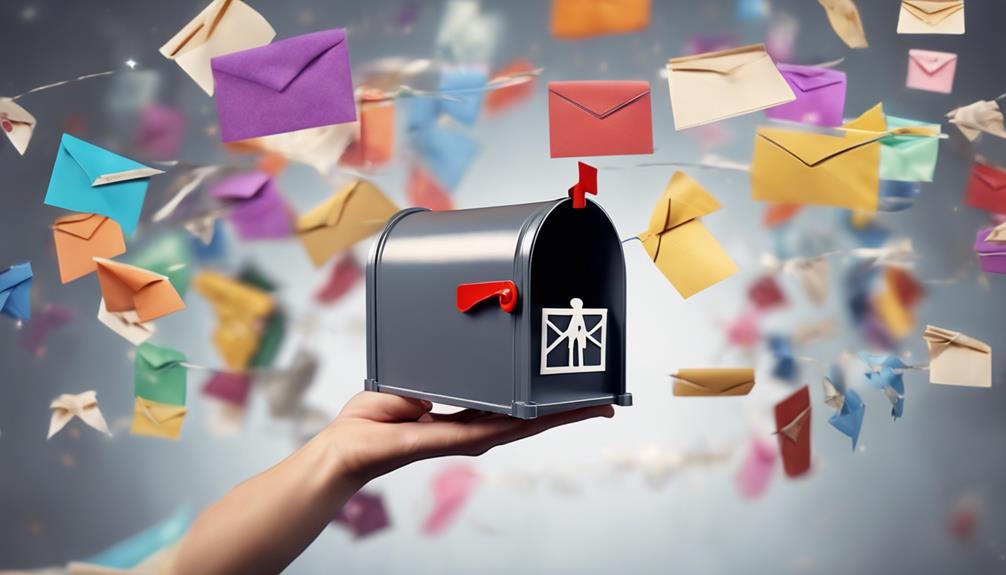Email Marketing for Non-Profit Organizations Tips
As a non-profit organization, you're likely no stranger to the challenges of fundraising and spreading your message. Email marketing can be a powerful tool in your arsenal, but it requires more than just sending out mass emails to your supporters. To truly drive engagement and conversions, you need to craft targeted campaigns that resonate with your audience. But where do you start? Building a quality email list is just the beginning. You'll also need to create engaging content, optimize your visual elements, and track your metrics to refine your strategy. But what specific tactics will set your email marketing efforts apart?
Key Takeaways
- Focus on acquiring email addresses from individuals who've explicitly opted-in to receive communications from the non-profit organization.
- Segment the email list to maximize engagement by dividing it into groups based on specific criteria, such as demographics, interests, or donation history.
- Prioritize emotional storytelling, leveraging the personal narratives of beneficiaries, donors, and volunteers to illustrate the impact of the non-profit's work.
- Use clear and compelling calls-to-action that drive recipients to take specific actions, increasing email open rates and response rates.
Build a Quality Email List
To build a quality email list for your non-profit organization, you'll want to focus on acquiring email addresses from individuals who've explicitly opted-in to receive communications from you, rather than purchasing or renting lists that may contain unengaged or uninterested recipients.
This approach guarantees that your list is comprised of supporters who are genuinely interested in your cause.
Effective list building strategies involve creating opportunities for individuals to opt-in to your email list.
This can be achieved through your website, social media channels, or in-person events.
Consider adding a sign-up form to your website's homepage, or creating a social media campaign that encourages followers to join your email list.
Once you've built a sizable list, it's crucial to segment it to maximize engagement.
Email segmentation involves dividing your list into groups based on specific criteria, such as demographics, interests, or donation history.
By segmenting your list, you can tailor your email content to specific groups, increasing the likelihood of engagement and conversion.
Creating Engaging Email Content
With a quality email list in place, your focus shifts to crafting compelling email content that resonates with your audience and drives meaningful engagement.
Your content strategy should prioritize emotional storytelling, leveraging the personal narratives of beneficiaries, donors, and volunteers to illustrate the impact of your non-profit's work.
This approach fosters an emotional connection with your audience, encouraging them to invest in your mission.
To create effective content, you must understand your audience's needs, preferences, and motivations.
Segment your list to guarantee tailored messaging, using data to inform your content decisions.
Consider using storytelling formats, such as video or personal accounts, to convey complex information in a relatable manner.
Furthermore, clearly communicate your ask – whether it's a donation, volunteer opportunity, or event invitation – certifying that recipients understand how they can support your mission.
Regularly analyze open rates, clicks, and conversions to refine your content strategy and optimize future email campaigns.
Visual Elements in Email Marketing
When crafting an email marketing campaign for your non-profit, you're not just writing a message – you're creating a visual experience that can make or break engagement.
You'll want to carefully consider the images and branding elements that represent your organization, as they can profoundly impact how your message is perceived.
Images and Branding
You consistently reinforce your non-profit's identity through carefully selected visual elements in email marketing, as images and branding play a pivotal role in conveying your mission and values to subscribers.
When incorporating images into your emails, prioritize image optimization to guarantee fast load times and a seamless user experience. This includes compressing image files to reduce file size and specifying the image's dimensions to prevent resizing. Additionally, using descriptive alt text for images enhances accessibility and allows subscribers to understand the content even if the image fails to load.
Maintaining brand consistency across all email communications is essential. This includes adhering to a standard color palette, typography, and tone of voice.
Your logo should be prominently displayed and easily recognizable, while imagery and graphics should reflect your non-profit's values and mission. Consistent branding helps build trust and recognition among subscribers, fostering a loyal community of supporters.
Graphic Design Best
Nearly 80% of subscribers perceive a brand's credibility based on visual elements in email marketing, making strategic graphic design pivotal to reinforce your non-profit's message and build trust.
As you craft your email campaigns, consider the visual hierarchy of your design. This refers to the arrangement of elements to guide the reader's eye through the content. Use size, color, and placement to draw attention to key information, such as calls-to-action or donation links.
Your color palette is also vital in conveying your non-profit's brand identity. Choose a palette that aligns with your organization's values and resonates with your target audience. Consistency is key, so verify that your email design reflects your brand's overall visual identity.
When selecting colors, consider the emotions and associations they evoke. For example, blue is often associated with trust and stability, while green conveys growth and harmony. By carefully crafting your visual elements, you can create an email design that not only engages your audience but also reinforces your non-profit's credibility and mission.
Managing and Tracking Metrics
Effective email marketing for non-profits relies heavily on managing and tracking key metrics to gauge campaign success, inform future strategies, and optimize donor engagement.
You need to focus on metric analysis to understand the performance of your email campaigns. This involves tracking metrics such as open rates, click-through rates, conversion rates, and unsubscribe rates.
By analyzing these metrics, you can identify areas of improvement and make data-driven decisions to optimize your campaigns.
Data segmentation is also vital in managing and tracking metrics.
You can segment your email list based on demographics, donation history, and engagement levels.
This allows you to create targeted campaigns that resonate with specific groups of donors.
By tracking metrics for each segment, you can refine your strategies and improve engagement.
For example, you can track the open rates and click-through rates for each segment to see which groups are most responsive to your campaigns.
Increasing Email Open and Response Rates
As you aim to boost the effectiveness of your non-profit's email marketing campaigns, crucially, you must focus on increasing open and response rates.
You can achieve this by refining key elements of your email strategy, including the subject lines that grab recipients' attention, the personalized content that resonates with them, and the call-to-actions that prompt them to take action.
Optimizing Subject Lines
Crafting a compelling subject line is crucial to boosting email open rates and driving responses for your non-profit organization, since it's often the first thing recipients see in their inboxes and can make or break their decision to engage with your message.
To optimize your subject lines, you'll want to focus on crafting lines that resonate with your audience and encourage them to open your emails.
Use emotional triggers: Incorporate words or phrases that evoke emotions, such as 'urgent,' 'exclusive,' or 'limited time offer.'
Keep it concise: Subject lines should be short and to the point, ideally under 50 characters.
Test and refine: Conduct subject line testing to determine which lines perform best with your audience and refine your approach accordingly.
Using Personalized Email Content
To boost engagement and conversion rates, you'll want to leverage personalized email content that speaks directly to your recipients' interests, needs, and motivations, using data-driven insights to tailor your messaging and create a more meaningful connection with your audience. This approach enables you to build trust and establish a stronger relationship with your supporters.
To achieve this level of personalization, consider implementing dynamic segmentation, which allows you to categorize your email list based on specific criteria, such as donation history, volunteer activity, or event attendance.
This enables you to create targeted groups and tailor your content to resonate with each segment.
Content tailoring is also vital in personalized email marketing.
Use data and analytics to understand your audience's preferences and behaviors, and adjust your content accordingly.
For example, if you notice that a particular segment is more likely to engage with stories about a specific program, use that insight to create targeted content that speaks to their interests.
Crafting Effective Call Actions
Every effective email marketing campaign relies on a clear and compelling call-to-action (CTA) that drives recipients to take a specific action, whether it's donating, volunteering, or attending an event, and research shows that well-crafted CTAs can increase email open rates by up to 28% and response rates by up to 22%.
As a non-profit organization, you want to make sure your CTAs are actionable, concise, and prominent in your email campaigns.
To craft effective CTAs, use clear language that tells recipients exactly what action to take. Avoid using vague language or jargon that might confuse them.
Use actionable language that starts with a verb, such as 'Donate Now' or 'Volunteer Today'. Keep your CTAs concise and to the point, avoiding unnecessary words or phrases. Use prominent placement for your CTAs, such as in the header or footer of your email, or in a prominent button.
Combining With Other Digital Channels
By integrating email marketing with other digital channels, such as social media and online advertising, non-profits can amplify their message, expand their reach, and drive more conversions.
This cross-channel approach enables you to leverage the strengths of each platform to create a cohesive and impactful campaign. For instance, you can use social media to build awareness and drive traffic to your website, while using email marketing to nurture leads and encourage donations.
To achieve social synergy, consider sharing your email content on social media platforms to extend its reach.
You can also use social media to promote your email campaigns and encourage subscribers to share your content with their networks.
Additionally, use data and analytics to track the performance of your cross-channel campaigns and make data-driven decisions to optimize your strategy.
By integrating email marketing with other digital channels, you can create a powerful and effective marketing strategy that drives real results for your non-profit organization.
Sending Email That Raises Donations
Crafting effective donation-driven emails requires a strategic approach that leverages compelling storytelling, clear calls-to-action, and personalized appeals to motivate your subscribers to give.
To maximize the impact of your email campaigns, consider incorporating donation incentives that encourage subscribers to contribute. This can include matching gift opportunities, exclusive updates on the impact of their donation, or recognition on your organization's website.
When designing your email campaigns, keep the following best practices in mind:
Use a sense of urgency to prompt subscribers to give, such as limited-time matching gift opportunities or deadlines for specific fundraising campaigns.
Segment your email list to confirm that subscribers receive targeted appeals that resonate with their interests and giving history.
Use social proof, such as testimonials from existing donors or updates on the impact of previous donations, to build trust and credibility with your subscribers.
Frequently Asked Questions
What Is the Ideal Email Frequency for Non-Profit Organizations?
You'll want to experiment with email cadence testing to find the sweet spot for your audience. Aim to optimize donation reminders, sending them when subscribers are most likely to engage, and adjust frequency based on response rates.
Can We Use Email Marketing Automation for Fundraising Events?
You can leverage email marketing automation for fundraising events by setting up event triggers that send targeted campaigns, and donation reminders to encourage timely contributions, ultimately streamlining your fundraising process and boosting donations.
How Do We Handle Email List Fatigue and Disengagement?
To combat email list fatigue and disengagement, you'll need to segment your list to tailor content to specific groups, then create engaging content that resonates with each segment, driving reactivation and conversions.
Can We Personalize Emails With Limited Donor Data Available?
You can still personalize emails with limited donor data by using data segmentation and targeted messaging. Focus on basic demographics, donation history, and engagement patterns to create relevant content and improve email effectiveness.
What Are the Best Email Subject Line Keywords for Non-Profits?
When crafting subject lines, you'll want to focus on keywords that drive action. Use words like "Help", "Donate", and "Support" to create an email appeal. Incorporate urgency messaging with words like "Limited Time" or "Deadline Approaching" to boost opens.
Conclusion
You've optimized your email marketing strategy for maximum impact.
By building a quality email list, crafting engaging content, and leveraging visual elements, you're driving conversions and donations.
With metrics tracking and refinement, you're continually improving.
Integrating with social media and online advertising amplifies your message.
Now, focus on sending emails that raise donations, and watch your non-profit's online presence thrive.
Analyze, adjust, and repeat to achieve long-term success.







